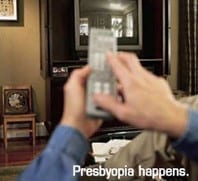
Inside the eye there is a lens about the size of a pea. To focus on close objects, a special muscle in the eye changes the shape of the lens. This process is called accommodation. With age the lens loses its flexibility and is less able to change its shape. This is a completely normal aging change, just like stiffening joints or graying hair. The loss in lens flexibility is the reason that close focusing becomes more difficult.
Everyone experiences the aging process that causes presbyopia. The condition cannot be prevented.

Presbyopia can be corrected by spectacles and/or contact lenses. It is important that the prescription is calculated for the distance at which you do your close tasks. Surgery can now correct for presbyopia through use of multifocal intra-ocular lenses and monovision, however there are associated risks and outcomes are not always ideal. A thorough discussion with your optometrist will enable you to decide on your best options.
Reading glasses, the primary correction for presbyopia will make near objects clear but distant objects blurry. This means that if you have a pair of spectacles just for reading, you will not he able to watch television while wearing them. Having different prescriptions for distance and reading can be a nuisance, especially if you have to change spectacles all the time. Bifocals, progressive lenses and ½ eyes have all been designed to reduce this problem, however in our current digital world we find ourselves prescribing specific glasses for specific tasks rather than a one size fits all.
Although your close focusing system is not functioning as well as it used to, once presbyopia has been corrected with spectacles, you will be able to see close things as well as you always did. Presbyopia does not represent a threat to your eye health and wearing spectacles will neither accelerate nor slow the development of presbyopia.
Between the ages of 45 and 65 years, your prescription is likely to change significantly. It is sensible to have your eyes examined every two years to review your correction and your general eye health. If you experience vision problems earlier, you should make a review appointment with your optometrist. Your optometrist will advise you of the most appropriate period between consultations.
Dr Ieuan H. Rees. (Optometrist)
Buck & Todd Optometrist
Located at 103 Alfred Street, Mackay, 4740.
